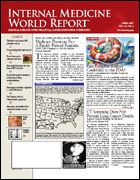GI Benefits of COX-2 Inhibitors Confirmed
But Should You Be Prescribing Them at All?
Questions about the use and safety of the selective inhibitors of cyclooxygenase (COX)-2, so-called coxibs, are getting a new life as new COX-2 inhibitors are now in the final stages of development. As new evidence points to their potential benefits, one persistent critic questions the wisdom of continuing the use of this drug class.
Gastroenterology
A new study that compared the gastrointestinal (GI) safety of the COX-2 inhibitors with that of the traditional, nonselective nonsteroidal antiinflammatory drugs (NSAIDs) showed that coxibs cause less GI toxicity than traditional NSAIDs, but their superior GI safety profile was completely negated by a concomitant use of aspirin (. 2007; 132:498-506).
This new nested case-control analysis identified 1561 patients (aged 40-85 years) with upper-GI complications—mostly duodenal bleeding (81%)—who were in the Health Improvement Network Database between January 2000 and 2005. A total of 10,000 age- and gender-matched patients served as the control group.
Overall, current NSAID use (n = 277) was independently associated with a 3- to 4-fold increased risk of upper-GI complications. Current use of a COX-2 inhibitor (n = 60) also increased risk, but not as dramatically (relative risk, 2.6). An approximate 2- and 3-fold increased risk was associated with rofecoxib (Vioxx) and celecoxib (Celebrex), respectively.
Among those who did not take aspirin, the use of a COX-2 inhibitor reduced the risk of upper-GI complications by 40%—a benefit that completely disappeared among aspirin users.
A dose-dependent relationship was reported between NSAIDs and upper-GI complications. Among NSAID users, the 2.5 relative risk associated with low-to-medium doses doubled to 4.9 with high doses. A similar relationship was found between coxib use and upper-GI complications, although the difference between low-to-medium and high doses was slightly muted. The risk was relatively consistent among short- and long-term coxib users.
“Concomitant medication with aspirin clearly cancels out the superior UGIC [upper-GI complications] safety profile of coxibs compared with [traditional] NSAIDs,” lead investigator Luis A. Garc“*”a Rodr“*”guez, MD, and colleagues write. They add, however, that “the risk of UGIC is clearly determined by the daily dose of the individual agent.”
These results beg the question as to whether there is any justifiable role for coxibs, given the fact that most patients who are at highest risk for GI damage also tend to be at risk of cardiovascular (CV) events and therefore may need to take low-dose aspirin, note editorialists Drs David Henry and Patricia McGettigan (pages 790-808).
This leaves physicians with a considerable dilemma in trying to balance the modest reduction in GI complications with the modest increased risk for CV events associated with the coxibs, Drs Henry and McGettigan say.
“If we were asked to choose between a gastrointestinal bleed or a heart attack or stroke, most of us will adopt the former,” they observe.
JAMA
David J. Graham, MD, MPH, a GI expert and senior drug safety researcher with the FDA, recommended a different approach to the treatment of patients who are at risk of GI complications in a recent editorial (. 2006; 296: 1653-1656). Dr Graham, who was a strong critic of rofecoxib when the infamous controversy emerged, still argues that physicians should avoid prescribing the COX-2 inhibitors. (Although only 1 agent is currently on the market, a second agent is currently in the final stages of development.)
Dr Graham’s approach, Drs Henry and McGettigan say, is one “that is difficult to argue with,” advocating the use of the traditional NSAID naproxen (Aleve) concomitantly with a proton pump inhibitor. He points out that, unlike the coxibs, data from a meta-analysis of randomized trials and observational studies concur that naproxen is neutral for myocardial infarction risk.
Dr Graham suggests that physicians should prescribe naproxen, not celecoxib, for patients with arthritis pain or for those with other conditions that require chronic pain relief. “For patients at high risk of NSAID-related gastrointestinal tract complications, naproxen plus a proton pump inhibitor is less costly and as effective, and probably safer, than low-dose celecoxib,” he writes.
In the future, the FDA must look beyond the “veiled and misleading ambiguity” that has shrouded previous trials leading to the approval of COX-2 inhibitors, he stresses. “If the lessons of recent history have been learned, the FDA’s concerns will now be squarely focused on patient safety rather than corporate profitability, and, ultimately, common sense will prevail.”
Key points
• Use of a COX-2 inhibitor can reduce GI toxicity risk by 40% compared with traditional NSAIDs.
• This superiority disappears, however, in coxib users who also take aspirin.
• Physicians must balance the GI safety profile of coxibs with their potential CV risk.
• One expert argues that prescribing naproxen (which does not carry CV risk) plus a proton pump inhibitor is a better approach.
